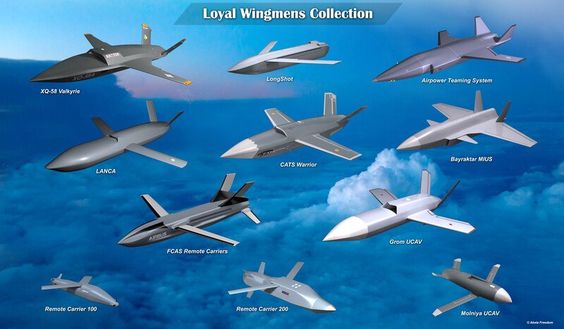
Manned-Unmanned Teaming (MUM-T) Concept. MUM-T encompasses the collaborative operation of manned and unmanned systems across various platforms and domains. It can apply to ground, maritime, and air operations. MUM-T emphasises seamless interoperability between manned and unmanned systems, allowing them to work together effectively across various mission profiles. This concept can involve multiple unmanned systems (e.g., UAVs, unmanned ground vehicles (UGVs), and unmanned surface vessels) working alongside manned platforms. MUM-T can encompass various mission types, such as surveillance, logistics, reconnaissance, and combat operations, providing commanders with various tactical options.

Loyal Wingman Concept. The loyal wingman concept refers specifically to unmanned aerial vehicles (UAVs) that operate closely with manned fighter jets, providing support and augmenting their capabilities during missions. These UAVs are designed to act as “wingmen” to manned aircraft. Loyal wingman drones are typically designed to operate autonomously or semi-autonomously, often using AI to make real-time decisions. They can perform a variety of roles, including reconnaissance, electronic warfare, and strike missions, thus relieving manned aircraft of certain tasks. Loyal wingman drones are often expected to fly in close formation with manned fighters, providing tactical support and enhancing the mission’s overall combat effectiveness.
When comparing Manned-Unmanned Teaming (MUM-T) and the Loyal Wingman concept head-to-head, both approaches leverage the collaboration between manned and unmanned systems but differ in their operational dynamics, levels of autonomy, and intended outcomes.
Mission Scope and Roles
MUM-T: In MUM-T, manned platforms directly command and control unmanned platforms to assist in various roles. MUM-T’s mission scope is broader, encompassing support and offensive capabilities. The Unmanned systems are typically extensions of the manned system’s sensors and weapons.
Loyal Wingman: Loyal Wingmen are designed to operate more autonomously, carrying out specific combat-related tasks, such as providing air support, engaging threats, or acting as decoys. They are essentially force multipliers, augmenting the combat power of the manned platform. These drones take on more combat-centric roles, where they can engage in offensive or defensive missions in coordination with human pilots.
Coordination/Control & Level of Autonomy
MUM-T: In MUM-T operations, unmanned systems rely more on direct control or at least supervision by the operator in the manned platform. The unmanned platforms can execute pre-programmed tasks but are generally controlled in real-time. The unmanned systems may not make complex decisions independently; instead, they execute commands provided by the manned platform. This keeps humans in the loop for crucial decision-making.
Loyal Wingman: The concept is based on a distributed coordination model. Loyal Wingmen are designed to operate with higher levels of autonomy. While they still collaborate with human pilots, they can make tactical decisions independently based on mission objectives and AI algorithms. They act like human wingmen, performing tasks such as engaging targets or defending the manned platform without the pilot’s constant input.
Primary Objectives
MUM-T: MUM-T focuses on enhancing situational awareness and extending operational reach. The unmanned systems help manned platforms by acting as force extenders—flying ahead to scout or gather intelligence, providing targeting data, or executing stand-off attacks to reduce risk to the human crew. The unmanned assets support and amplify the capabilities of the manned aircraft.
Loyal Wingman: Loyal Wingman focuses on amplifying combat effectiveness. The drones serve as partners in combat, providing additional firepower, protecting the manned platform, or taking on riskier roles like flying into heavily defended areas or serving as decoys. The objective is to have these drones work in combat formations, improving the lethality and survivability of the overall mission.
Combat Scenarios
MUM-T: Best suited for missions that involve complex battlefield management, including reconnaissance, data gathering, and precision strikes. It excels in operations where information dominance is critical and human decision-making is essential.
Loyal Wingman: More suited for frontline combat missions, where the wingman provides direct combat support and enhances the combat effectiveness of the manned platform. They can take on high-risk missions, allowing the manned aircraft to stay back and command from a safer distance.
While the loyal wingman focuses on the relationship between unmanned and manned aircraft, MUM-T provides a more expansive framework for integrating various platforms across different military domains. These concepts represent a shift toward more adaptive, resilient, and capable military forces. The loyal wingman concept and MUM-T are critical to the future of military operations, as they leverage technological advancements to enhance combat effectiveness.
Your valuable comments are most welcome.
For regular updates, please register your email here:-
References and credits
To all the online sites and channels.
Disclaimer:
Information and data included in the blog are for educational & non-commercial purposes only and have been carefully adapted, excerpted, or edited from reliable and accurate sources. All copyrighted material belongs to respective owners and is provided only for wider dissemination.
